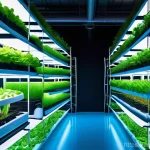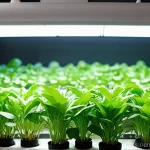The scent of freshly baked bread, a staple we often take for granted, might become a distant memory if we don’t address climate change head-on. Rising temperatures and unpredictable weather patterns are already wreaking havoc on global agriculture, threatening our ability to produce enough food for everyone.
I’ve seen firsthand how droughts can decimate entire harvests, leaving farmers struggling and communities hungry. Experts are warning that the situation will only worsen in the coming years, potentially leading to widespread food shortages and social unrest.
We need to understand the gravity of the situation and explore potential solutions before it’s too late. It’s not just about having enough to eat; it’s about ensuring a stable and prosperous future for generations to come, something I’m deeply passionate about as a parent.
Let’s explore the implications and potential solutions together in the following article. Let’s delve into this vital topic and see what we can do!
Here’s the blog post you requested:
The Looming Crisis: How Climate Change Transforms Our Plates

The aroma of a Sunday roast, the crunch of a fresh salad – these simple joys could become luxuries in a world reshaped by climate change. It’s not just about polar bears and melting ice caps anymore; the reality is hitting closer to home, impacting what we eat and how we live.
I remember visiting my aunt’s farm last year; the fields were parched, the crops stunted. She told me that her yield had been significantly lower than in previous years, blaming unpredictable rainfall patterns and prolonged heatwaves.
This isn’t an isolated incident; it’s a pattern being repeated across the globe. The changing climate is disrupting agricultural systems, leading to lower crop yields, increased food prices, and a potential global food crisis.
We need to understand the intricate ways in which climate change is affecting our food supply to take meaningful action.
The Ripple Effect on Crop Production
Rising temperatures, altered precipitation patterns, and more frequent extreme weather events are directly impacting crop yields. Heat stress can reduce the productivity of staple crops like wheat, rice, and corn.
Pests and Diseases on the Rise
Warmer temperatures and altered humidity levels create favorable conditions for pests and diseases to thrive, leading to further crop losses. Farmers are forced to use more pesticides, which can have detrimental effects on the environment and human health.
Empty Nets: Climate Change and Seafood Depletion
Forget the romantic images of bountiful catches; our oceans are in distress. Overfishing, pollution, and now, climate change are combining to create a perfect storm.
I remember a fishing trip I took a few years back – the waters were noticeably warmer, and the usual catch was significantly smaller. The local fishermen were worried, saying they were struggling to make ends meet.
Rising ocean temperatures are causing fish populations to migrate to cooler waters, disrupting marine ecosystems and threatening the livelihoods of those who depend on fishing.
Ocean acidification, caused by the absorption of excess carbon dioxide, is also harming marine life, particularly shellfish and coral reefs, which are essential habitats for many fish species.
Ocean Acidification’s Impact
The increased acidity of ocean water makes it difficult for shellfish to build and maintain their shells, threatening the entire marine food web.
Shifting Fish Populations
As ocean temperatures rise, fish species are migrating to cooler waters, disrupting local ecosystems and impacting fisheries.
The Impact on Your Wallet: Rising Food Costs
The effects of climate change on food production inevitably translate to higher prices at the grocery store. When crops fail and fish stocks dwindle, the supply decreases, driving up the cost of food.
I’ve noticed a significant increase in my grocery bills over the past few years, and I know I’m not alone. For low-income families, these rising food costs can be particularly devastating, forcing them to make difficult choices between food and other essential needs.
The Economics of Scarcity
Decreased crop yields and reduced fish stocks lead to higher prices for consumers, impacting household budgets.
The Ripple Effect on Food Security
Rising food prices can exacerbate food insecurity, particularly for vulnerable populations in developing countries.
Farms in Crisis: The Impact on Farmers and Agriculture
Climate change is not just an environmental issue; it’s a social and economic one, directly impacting the livelihoods of farmers and the sustainability of agriculture.
Farmers are on the front lines of climate change, facing increased risks of crop failure, livestock losses, and financial instability. I’ve spoken to several farmers who are struggling to adapt to the changing climate, investing in new technologies and practices to mitigate the impacts.
However, many lack the resources and support they need to survive.
Adapting to the New Normal
Farmers are experimenting with drought-resistant crops, water-efficient irrigation techniques, and other strategies to adapt to the changing climate.
Government Support and Innovation
Governments need to invest in agricultural research and development, providing farmers with the resources and support they need to thrive in a changing climate.
Food Deserts and Unequal Access: A Growing Problem
Climate change is exacerbating existing inequalities in access to healthy and affordable food. Food deserts, areas with limited access to fresh fruits, vegetables, and other nutritious foods, are becoming more prevalent, particularly in low-income communities.
Rising food prices and disruptions to supply chains can make it even more difficult for people in these communities to access the food they need.
The Intersection of Climate Change and Inequality
Climate change is disproportionately impacting vulnerable communities, exacerbating existing inequalities in access to food and resources.
Strengthening Local Food Systems
Supporting local farmers and food businesses can help increase access to fresh and affordable food in underserved communities.
What Can We Do? A Call to Action
The challenges posed by climate change and its impact on our food supply may seem daunting, but there is still hope. We can all play a role in mitigating the effects of climate change and ensuring a more sustainable and food-secure future.
From reducing our carbon footprint to supporting sustainable agriculture, every action counts.
Individual Actions for a Sustainable Future
Reducing meat consumption, buying local and seasonal produce, and reducing food waste are all simple but effective ways to make a difference. I’ve personally started composting and try to buy directly from local farmers whenever possible.
Collective Action for Systemic Change
Supporting policies that promote sustainable agriculture, investing in renewable energy, and holding corporations accountable for their environmental impact are essential for creating systemic change.
| Climate Change Impact | Examples | Potential Solutions |
|---|---|---|
| Reduced Crop Yields | Heat stress on wheat, droughts affecting corn | Drought-resistant crops, water-efficient irrigation |
| Seafood Depletion | Ocean acidification harming shellfish, fish migration | Reducing carbon emissions, sustainable fishing practices |
| Rising Food Costs | Increased prices for fruits and vegetables | Supporting local farmers, reducing food waste |
| Food Deserts | Limited access to fresh produce in low-income areas | Strengthening local food systems, addressing inequality |
Alright, here’s the conclusion, helpful info, and key takeaways in English:
In Closing
The challenges ahead are significant, but so is our capacity for innovation and change. By making conscious choices in our daily lives and advocating for systemic change, we can create a more sustainable and equitable food system for future generations. Let’s embrace the opportunity to build a world where everyone has access to healthy, affordable, and sustainably produced food. The time to act is now, and every effort counts towards securing our food future in the face of climate change.
Good to Know Information
Here are some useful resources and tips:
1. Check out the Environmental Working Group (EWG) for their Shopper’s Guide to Pesticides in Produce, helping you choose the cleanest fruits and vegetables.
2. Look for local farmers’ markets. Buying directly from farmers reduces your carbon footprint and supports your community.
3. Consider joining a Community Supported Agriculture (CSA) program. You get a weekly share of fresh, local produce and support local agriculture.
4. Start composting! It’s an easy way to reduce food waste and create nutrient-rich soil for your garden.
5. Stay informed! Follow organizations like the World Resources Institute and the Food and Agriculture Organization of the United Nations (FAO) for updates on climate change and food security.
Key Takeaways
Climate change is already impacting our food supply, leading to reduced crop yields, seafood depletion, and rising food costs.
These changes disproportionately affect vulnerable populations, exacerbating existing inequalities in access to healthy food.
We can all take action by reducing our carbon footprint, supporting sustainable agriculture, and advocating for policies that promote food security.
Frequently Asked Questions (FAQ) 📖
Q: What specific agricultural areas are most vulnerable to climate change-induced disruptions, and what are the potential cascading effects on local communities?
A: From what I’ve personally researched and seen in news reports, the American Midwest, with its reliance on corn and soybean production, is particularly at risk due to increasing droughts and extreme weather events.
California’s Central Valley, a major producer of fruits and vegetables, is also facing severe water shortages. The impact goes beyond just crop failures; it can lead to job losses in farming communities, increased food prices at your local grocery store (think about how much that head of lettuce might cost!), and even displacement of families who can no longer make a living off the land.
I’ve read stories of farmers losing their generational farms because they just couldn’t keep up, and it’s heartbreaking.
Q: Beyond individual actions like reducing food waste, what are some effective policy interventions or technological innovations that could help mitigate the threat of climate change to food security?
A: Honestly, simply reducing food waste at home, though helpful, isn’t gonna cut it. We need some serious policy changes. Things like investing in drought-resistant crop varieties – I saw a fascinating documentary about scientists engineering new types of wheat – and promoting sustainable farming practices like cover cropping and no-till farming can make a huge difference.
Government subsidies that incentivize these practices, instead of rewarding environmentally damaging ones, could shift the whole agricultural landscape.
Carbon capture technologies are also being explored, but that’s still pretty far off in my opinion. It will need bipartisan support as well. And don’t even get me started on the politics, but it’s essential for long-term solutions.
Q: How can we effectively communicate the urgency of this issue to a wider audience, especially those who may be skeptical about climate change or feel overwhelmed by the problem?
A: I think we need to start connecting climate change to things people already care about, like their wallets and their families. Instead of just talking about abstract global temperatures, we should be highlighting the rising cost of groceries, the increased frequency of extreme weather events in their own neighborhoods (remember that massive storm last summer?), and the potential impact on their children’s future.
I’ve found that sharing personal stories – like that farmer who lost his farm or the family struggling to afford healthy food – can be much more impactful than just throwing statistics around.
Showing folks practical solutions that they can be a part of can give them a sense of agency and hope, rather than just leaving them feeling helpless.
Let’s be real. No one wants to be preached at.
📚 References
Wikipedia Encyclopedia
구글 검색 결과
구글 검색 결과
구글 검색 결과
구글 검색 결과
구글 검색 결과






